



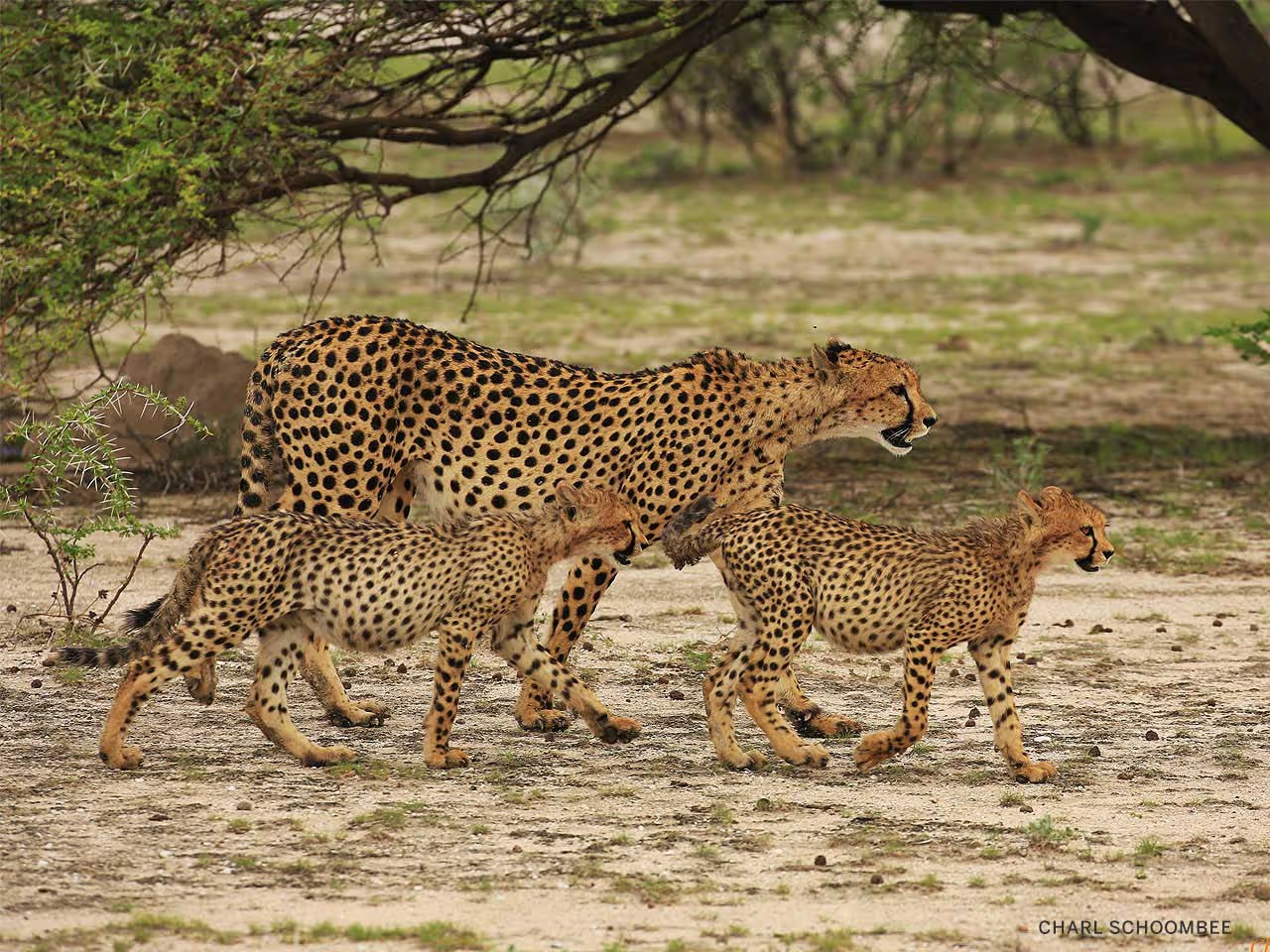
So what else does the heart of the land offer? It’s often overlooked by tourists who zoom towards the big names, but this area is wild. Rolling hills and rural farmlands rub shoulders with mountain ranges and game reserves. World renowned conservation projects have parked up and made their bases here - alongside national parks, nature reserves and geological sights to thaw the grumpiest historian.
This article will walk you through the highlights of Central Namibia's many attractions. They’re all just north of the capital Windhoek and undeniably convenient if you’re flying in. We’re talking about some of the Os of Namibia -Okahandja, Okonjima, Otjiwarongo, Outjo and Omaruru - and of course the massive Waterberg Plateau and massive Erindi Game Reserve. Let’s go. Anti-clockwise.
Head north from Windhoek, about 70km, on the B1 and you find yourself in the Capital of the Herero. Welcome to Okahandja, where two rivers meet. A place founded by the Namas and Hereros in the 1800's. Back then this served as a tribal centre for the Hereros that came from the north, now known as Angola.
Despite a treaty being signed here in 1890 between the Herero and the Germans, disagreement between them lead to the Battle of Waterberg in 1904. This resulted in the Herero being expelled into the Omaheke, where thousands of the tribe died of thirst. Known as the first genocide of the 20th century, it is clear that this town, inhabited now by roughly 25,000, has a great story to tell.
Visit the area to celebrate Herero Day, on August 26th annually, in commemoration of its past and you'll see a town filled with the colourful dresses and cattle horn shaped head dresses of the Herero culture. A tribe that even today, still see Okahandja as their epicentre.
If you aren't going to be there on said day in August, you'd still likely see Herero woman in their traditional dress in lesser numbers if passing through. Either heading from Windhoek to the Waterberg or perhaps from the Coast heading back to Windhoek. Stop here to view the largest wood carver's market in the country and buy some locally crafted goods for yourself or as a gift for the family back at home.
South-east by 10km takes you to Von Bach Dam and surrounding farmsteads. South-west by 25km, you will find the thermal springs of Gross Barmen. History and a hint of culture might draw you here but you are more likely to stay in the surrounds to avoid a night in the city of Windhoek.

Okonjima's next on our tour of Central Namibia. This 22,000-hectare private nature reserve is surrounded by the the Omboroko Mountains and the home of The AfriCat Foundation.
Here’s a paragraph on what they’re all about: so, there aren’t many humans living in Namibia but there are a lot of animals. And these animals have a right (surely?) to enjoy their vast homeland. But so do the humans. And this is a problem. Imagine you’re living life as a remote farmer trying to make enough food to, well, basically live. Now imagine your neighbours are predators. Predators who’ve taken one look at your lovely livestock and thought, hmm, they look very tasty indeed. And that leads to human-wildlife conflict. Which is frankly understandable, whichever side of the fence you’re on.
Conservationists have been working hard for years now to come up with workable solutions. And the AfriCat Foundation is one of the most famous and successful organisations of the lot. They’re based here in Okonjima and their work has put this place firmly on the map. Globally. If you visit, you’ll see their work in action - and you can even stay on the family farm which remains AfriCat's base.
So, who are they? Well, they’re a family-run, non-profit organisation which really got going in 1991. Their mandate? To assist with the long term conservation and rehabilitation of carnivores like cheetah, leopard, brown hyena and that African icon, lion.
And they know what it feels like to be farmers too. The Hanssen family settled here in the 70s, and they experienced extreme cattle loss as cheetah and other predators, took their livestock. Hunting, trapping and shooting didn't help, so, in a can't beat 'em, join ‘em kinda way they decided to try conservation.
AfriCat now provides solutions through education and support. On a practical level their projects have included building basic pens for farmers to keep their livestock in at night; they’ve employed local ‘lion guards’ to let the community know when predators are about; they’ve built a school and they’ve tried to help locals realise that they too can benefit from the money, jobs and (ironically) security predators can bring through gold encrusted tourism. They even run a youth education programme which focuses on this as they want young people to understand the importance of wildlife conservation. The programme has already reached 20,000 children.
But it’s not just about people. They also rehabilitate orphaned or injured animals with the aim of releasing them back into the wild. Since 1993, over 1,000 predators have been saved with 86% released.
You can stay here and visit their Carnivore Care Centre and they have their own game viewing vehicles. You could see cheetah, wild dog and hyena in their natural home - leopards are radio tracked so you could get lucky and spot them too. 250 bird species think it’s an ideal spot and there’s a hide for watching nocturnal animals.
You could also time your trip to attend AfriCat’s Annual Big Cat Health Examination weekend. Tourists are allowed to join specific tours which give you a rare opportunity to see cheetahs close up over two days - assisting vets with vaccinations, watching health examinations, weighing, blood sampling and even administering contraceptive implants where needed.
It really gives you an insight into the life and lot of Namibia’s predators as well as showcasing the importance of big cat conservation. And you’ll join an impressive VIP visitors list... Brad Pitt and Angelina Jolie, Joanna Lumley, Wesley Snipes, Linford Christie, Ian Wright... and there's a space for your name too.
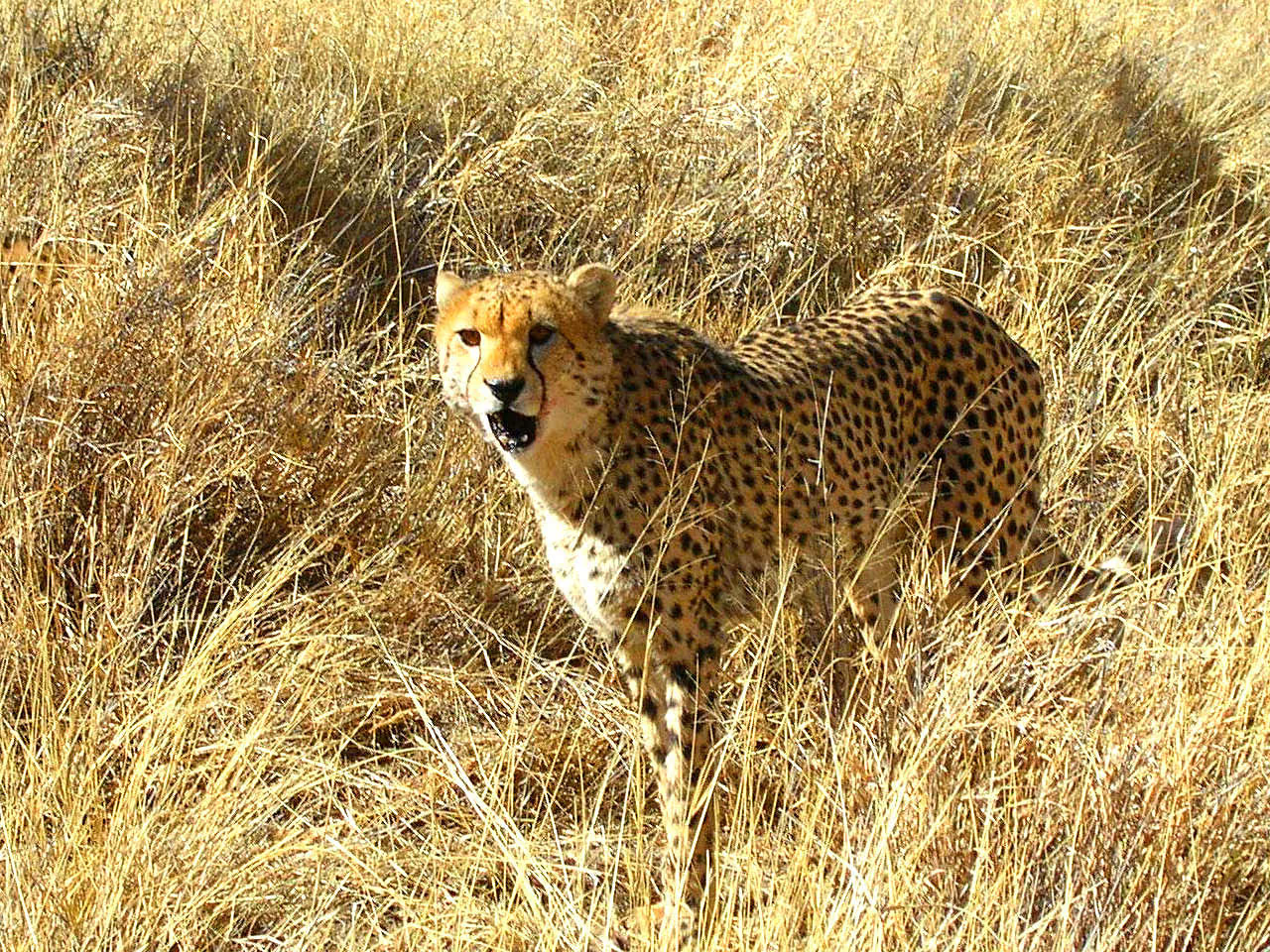
Now head north 70km and you’ll reach Otjiwarongo. This is home to the Cheetah Conservation Fund. These guys are another non-profit organisation specifically dedicated to saving the cheetah from extinction. They’re a world class research facility who study the biology, ecology and genetics of this great cat. Their base is several amalgamated game farms with private lodges on the western side of the Waterberg Plateau Park.
Cheetahs are the world's fastest land mammal. The one that gets to 100 km/h in three strides and in as few seconds. The one with it's melancholic tear-stained face (that's the easy way to know it's not a leopard). About 3,000 of them - that’s a third of the world's population - live in Namibia. Their genes are considered the purest and their continuing survival is due, in no small part, to conservation efforts in the country’s epicentre.
The lodge here is run by the Cheetah Conservation Fund, it’s pretty new as it only opened in 2017, but it’s the ideal place to stay - if you want to immerse yourself in pure cheetah land. If you’re interested/curious/passionate you can watch the feeding of the cats that can never be released, go on drives on the reserve and take some marvellous photos. We kid you not. Professional wildlife snappers seek out this place to capture images of a predator you can never normally get that close to. That says it all.
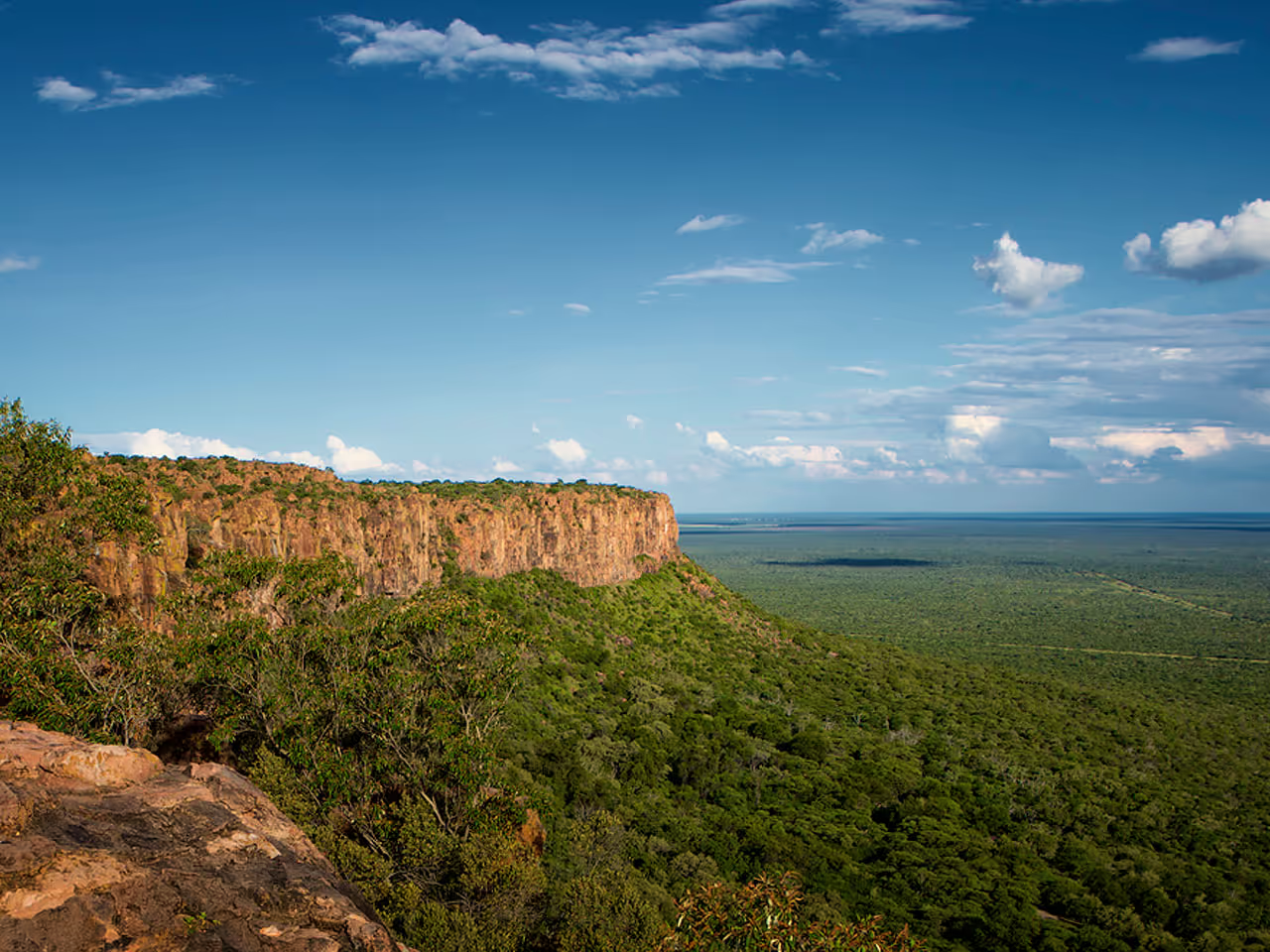
If you’ve just visited the Cheetah Conservation Fund you may have a taste for this next place, seeing as their research centre looks upon it.
Wow, there’s nothing quite like the Waterberg Plateau in Namibia. Rising high above the surrounding desert, the red sandstone plateau is 50 km long and 16 km wide. It’s home to rare species and has supported a wide diversity of flora and fauna for thousands of years - but - sometimes hard work is not enough.
Poor Waterberg, it’s often discarded as a one night stand by tourists hot footing it up to Etosha. And yet, this region is rich and varied and not just a stopover en route to the big guy. You actually get exceptional private safaris here, with luxury accommodation, plus good big game sightings. There are also two excellent - and very popular - hikes. One is guided, with no set route, and the other is a self-guided demarcated trail. Both immerse you in Namibia’s great wilderness.
The plateau and surrounding land was declared a Nature Reserve in 1972. And, because it’s largely inaccessible, several of Namibia's endangered species have been relocated here to protect them from predators and poaching. The vegetation is a mix of open grassland and acacia woodland. And because several springs well up, the undergrowth is lush and it’s all just rather lovely for humans and wildlife. Rare species include white rhino, buffalo, and sable and roan antelope have also been introduced. Existing game includes giraffe, kudu, leopard, hyena and cheetah.
And, ok, it’s not Etosha, but it’s darn well worth more than a cursory squiz as you charge on by.
The next stop en route from Otjiwarongo to the southern side of Etosha National Park, you are likely going to pass through here at some point either coming from or going to Etosha National Park. The emphasis on passing through.
Founded by German Colonial Troops in 1897, Outjo served as a military base to explore German South West Africa, as then known. Meaning "small hill" in Otjiherero, that is really all there is to it, other than it's popular bakery and few surrounding farmsteads and private game farms. Worth the visit as a stopover to your next destination. This town is typical of Namibia's small inland towns inhabited by only a few thousand who call it home.
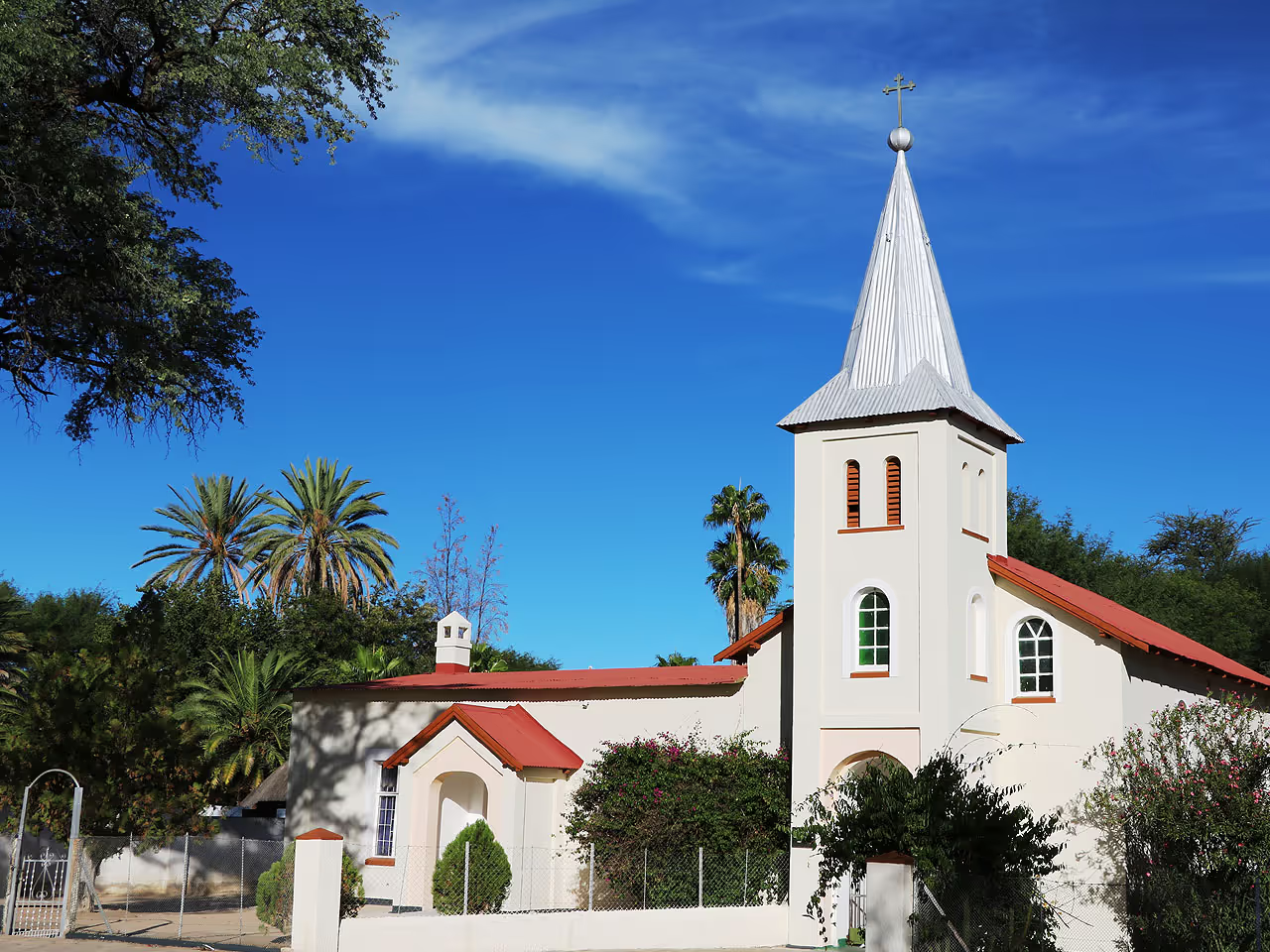
First things first. This town has a stunning backdrop, the Erongo Mountains. Which give it a head start in terms of downright gorgeousness.
To the Herero people, Omaruru means 'bitter milk'. And the story goes that local cows liked a local bush which made their milk rather bitter. This town is a dusty old girl, languishing beside a dry old river. But the large ground water reserves have made the surrounding soil pretty fertile and Omaruru a veritable oasis.
So fertile in fact, that this place is home to one of Namibia’s very few wineries. Which is a bit surreal, seeing as you’re pretty much wine tasting in the Namibian outback. Oh, and they make good cheese and chocolate too.
Omaruru has long been a trading centre for cattle and game farmers and the Herero community have an annual festival commemorating their history. It’s also been adopted by many artists who have added touches of colour and quirk hither and thither. and an excellent annual festival and artists' trail. Arrive from the south side and you’ll see these massive sculptures called the Tikoloshe root carving project - birds and animals all carved from hard wood tree roots.
Omaruru has a museum as well, and close to the town you’ll find Paula’s Cave which is famed for rock art. And talking of ancient wonders, there are actually some dinosaur footprints at the nearby village of Kalkfeld. This is the gateway to the Etjo Mountain where, 175 million years ago, dinosaurs went sight seeing. Some of their footprints have been perfectly preserved in a 25m stretch of sandstone terrain.
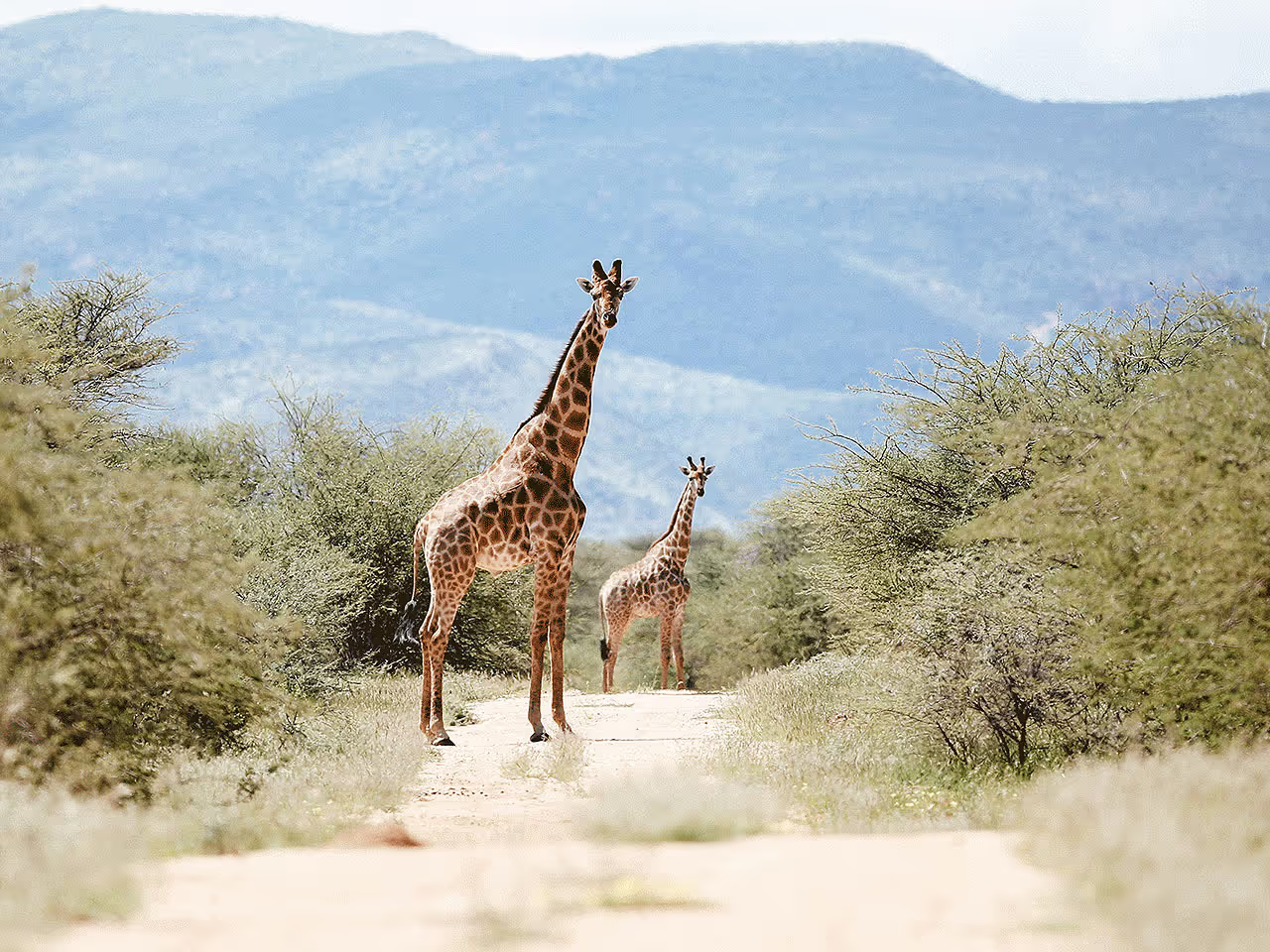
An hours drive east will take you to Namibia’s largest private game reserve Erindi Game Reserve. In a remarkably short space of time, this place has become an African safari destination in its own right. And we’ve almost gone full circle now as it’s almost as close to Okahandja too.
Erindi enjoys the best of both worlds - savannah grasslands and rugged mountains. It’s been a massive passion project and conservation venture, providing a 70,000 hectare home to more than 10,000 animals. Lion, leopard, cheetah, wild dog, elephants, black rhino, giraffe, hippo, crocodile and wildebeest. You could get lucky and spot the elusive pangolin too. Birdlife is prolific as well with over 300 species. The reserve may not be as big as Etosha, but it does offer some of the best game-viewing experiences in Namibia, plus night drives and guided bush walks too. And there’s a large waterhole.
You can also accompany a telemetry guide who tracks tagged animals. These may include lion, elephant, cheetah, serval, honey badger, wild dogs, brown or spotted hyena, all depending on transmitters at the time. Animals are located via radio telemetry and sightings are created for game drives.
For history buffs, there’s incredible San rock art to marvel at. Archaeological evidence suggests that this area was occupied by many prehistoric cultures over a long period of time. The oldest of these are the San, who were responsible for all the rock art in the reserve. The engravings are mostly found on boulders on rocky outcrops, while the largest site is above a riverbed. There are literally hundreds of engraved animal figures.
Erindi is a special place to retreat to. There’s a rich cultural heritage and knowledgeable guides all in a gorgeous setting. Stay in luxury accommodation at Old Traders' Lodge.
And that completes our cyclical tour of Central Namibia. It’s not just the point on the compass, central Namibia is the heart of the country, the circular O of the oryx, the national animal. The one with elegance, pride and a calm, quiet beating heart. Come see for yourself.




"A dream come true"
We had the most amazing family holiday, everything worked so perfectly, the arrangements and accommodation was spectacular!
"Unforgettable trip to Namibia – Thank you Namibia Tours & Safaris!"
We are a group of four from Romania and spent 3 unforgettable weeks in Namibia. We can't recommend them enough, and for any future travels in Namibia or other parts of Africa, we will definitely use their services again.
"We had a great experience"
From the time we put the key in the ignition till we boarded the plane in Windhoek nothing went wrong.
"Unforgettable bird photography trip in Namibia"
It was a fantastic experience, everything was very well organised, went smooth and according to expectations. It was our first self drive in Africa and it was a great, unforgettable time.